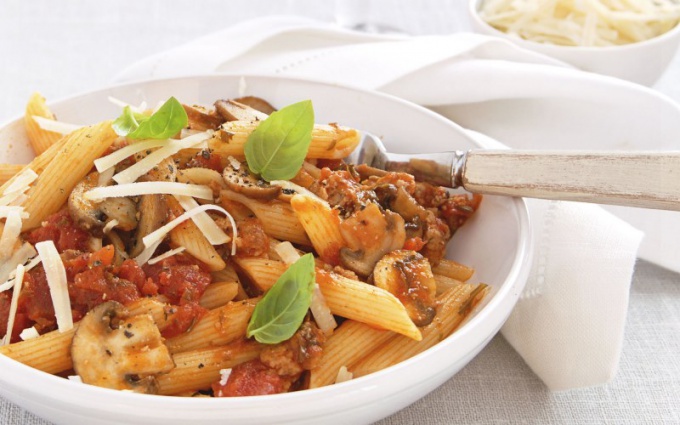Pasta in Italy is called almost any pasta, regardless of shape and size. Thus the same word is denoted by and the dish made from them.
In cooking the term "al dente" refers to a degree of readiness of the garnish, and it can apply not only to pasta but also to other species such as rice. The term itself is a transcription of the Italian expression "al dente", which can be translated as "to the tooth". In this case, meant that the process of preparation of a side dish degree of its readiness is selected such that when a soft upper layer, it kept the elastic core.
This method of cooking loved by gourmets not only because it gives the dish the right texture, where it is the ingredients, on the one hand, form a single whole, and on the other hand, each of them has a certain isolation due to the fact that they are not clumped together. In addition, pasta, rice or other side dish, thus prepared, has a lower glycemic index in comparison with the option of cooking, which requires full readiness. This can be important for people with elevated blood sugar levels.
Real pasta made from durum wheat, to a state of complete readiness usually have to cook at least 7 minutes. Thus, "al dente" can be achieved if you cook the paste for 5-6 minutes.
However, it should be borne in mind that the cooking time of different types of pasta to "al dente" can vary greatly depending on its type. So, thicker wall separate type of pasta or a larger size of one unit of product will lead to what for its preparation will need much more time than pasta, crushed to a greater extent.
Therefore, in order to properly cook pasta "al dente", experts in the culinary field is recommended to study the label of the product you purchased. It will see the recommended cooking time, and to achieve the "al dente", it should be cook for 1-2 minutes less than indicated on the package. However, in order to obtain a guaranteed result, experienced chefs recommend before you remove the pasta from the heat, taste and make sure it has reached the desired degree of readiness, and only then turn off the stove.
"Al dente"
In cooking the term "al dente" refers to a degree of readiness of the garnish, and it can apply not only to pasta but also to other species such as rice. The term itself is a transcription of the Italian expression "al dente", which can be translated as "to the tooth". In this case, meant that the process of preparation of a side dish degree of its readiness is selected such that when a soft upper layer, it kept the elastic core.
This method of cooking loved by gourmets not only because it gives the dish the right texture, where it is the ingredients, on the one hand, form a single whole, and on the other hand, each of them has a certain isolation due to the fact that they are not clumped together. In addition, pasta, rice or other side dish, thus prepared, has a lower glycemic index in comparison with the option of cooking, which requires full readiness. This can be important for people with elevated blood sugar levels.
Cooking time
Real pasta made from durum wheat, to a state of complete readiness usually have to cook at least 7 minutes. Thus, "al dente" can be achieved if you cook the paste for 5-6 minutes.
However, it should be borne in mind that the cooking time of different types of pasta to "al dente" can vary greatly depending on its type. So, thicker wall separate type of pasta or a larger size of one unit of product will lead to what for its preparation will need much more time than pasta, crushed to a greater extent.
Therefore, in order to properly cook pasta "al dente", experts in the culinary field is recommended to study the label of the product you purchased. It will see the recommended cooking time, and to achieve the "al dente", it should be cook for 1-2 minutes less than indicated on the package. However, in order to obtain a guaranteed result, experienced chefs recommend before you remove the pasta from the heat, taste and make sure it has reached the desired degree of readiness, and only then turn off the stove.

